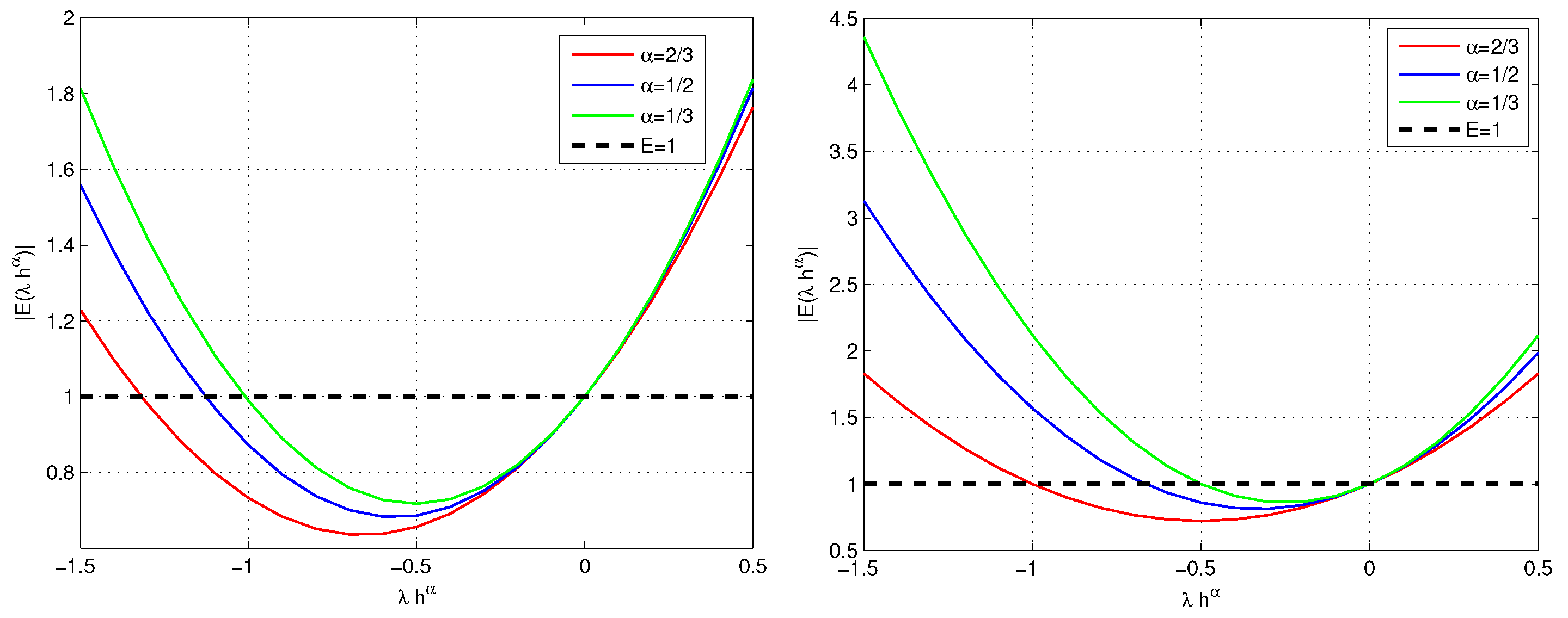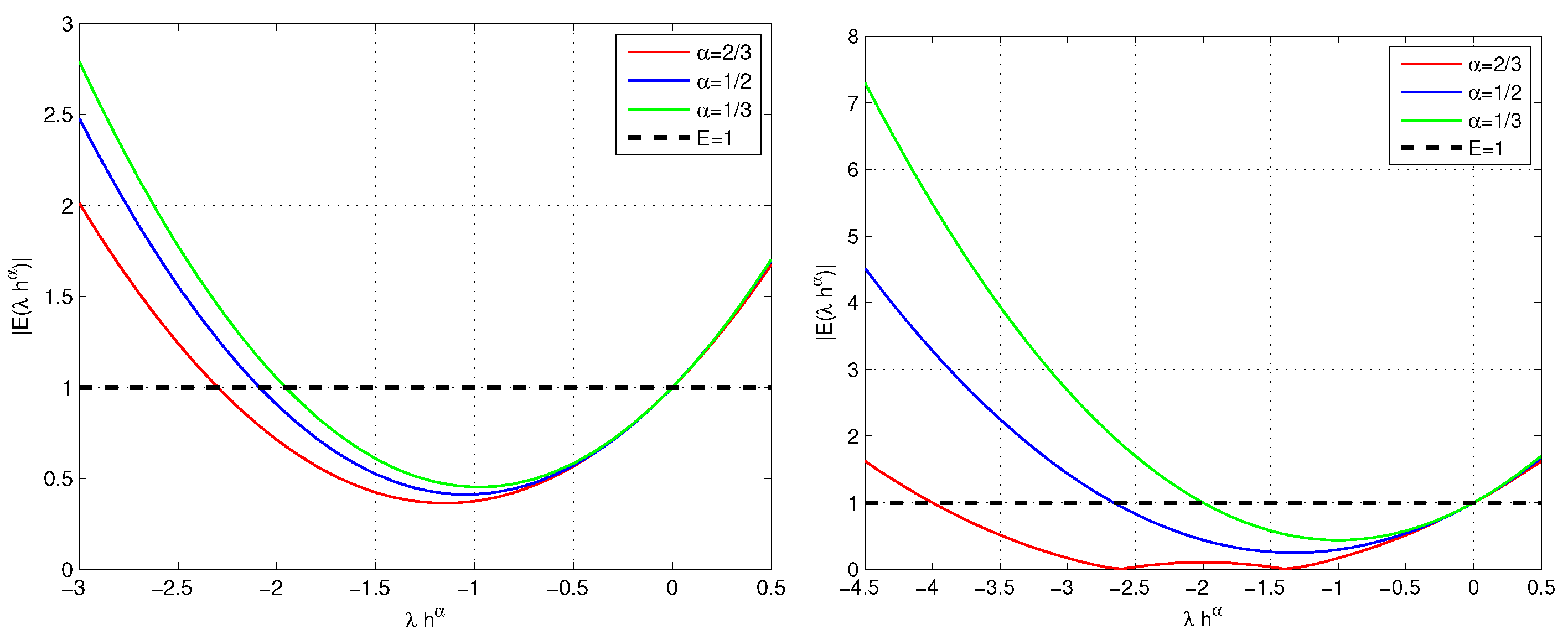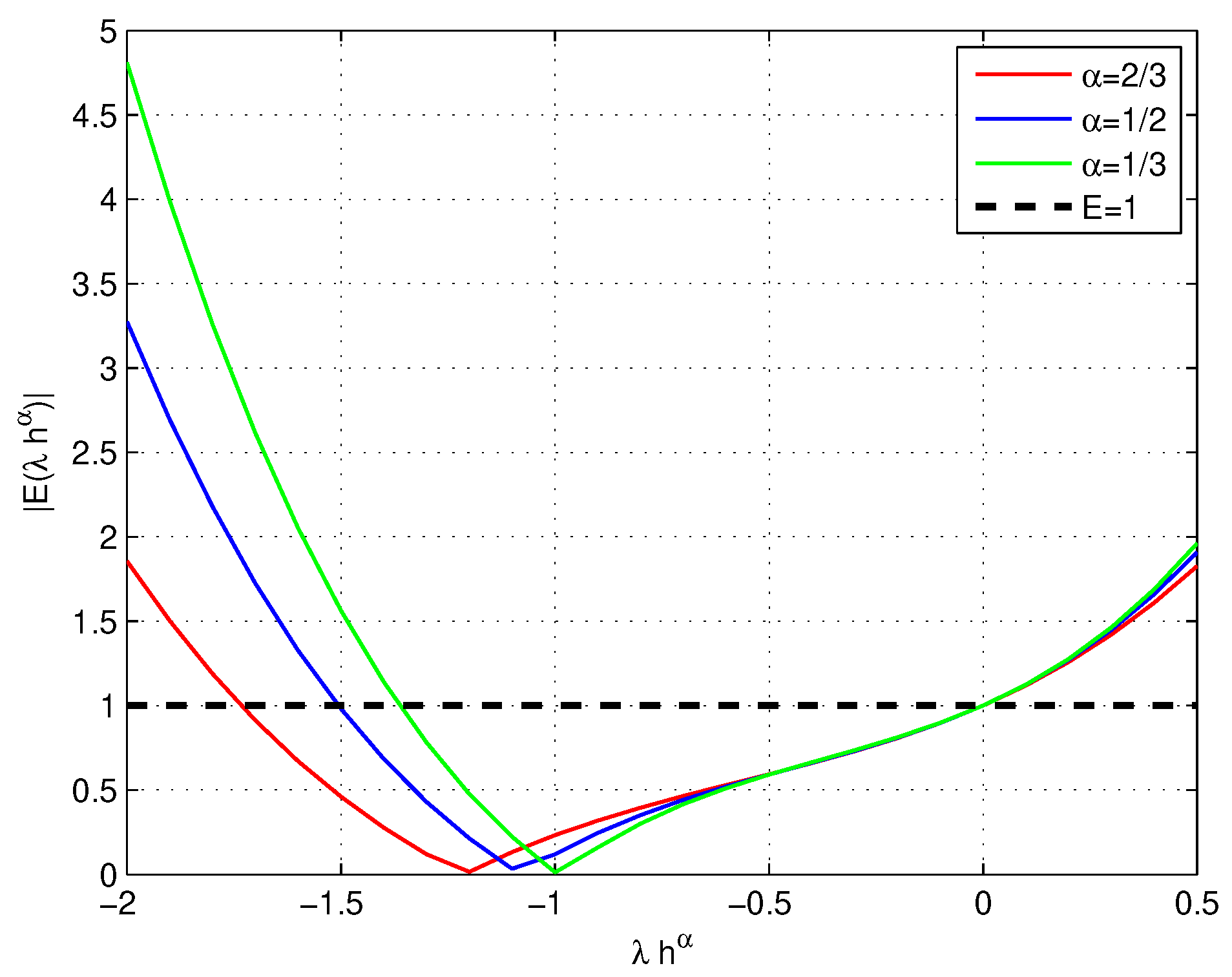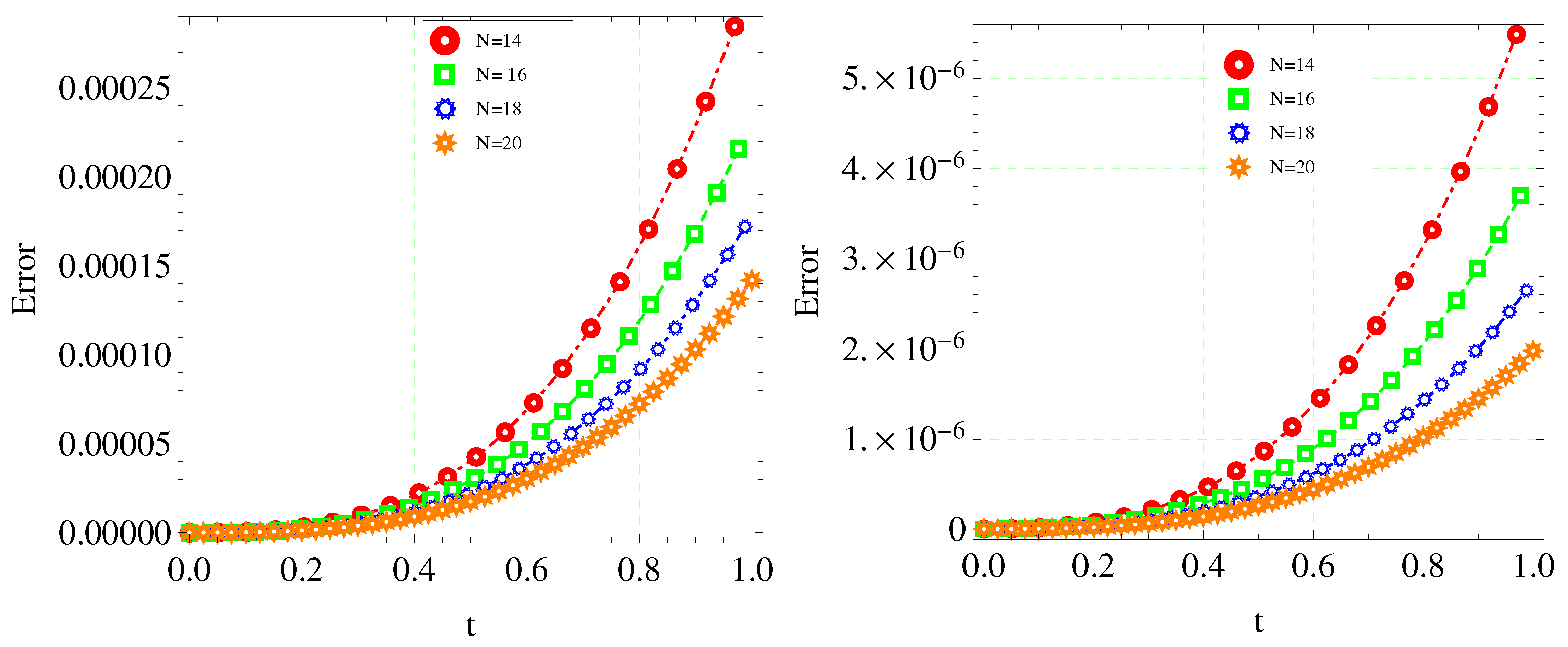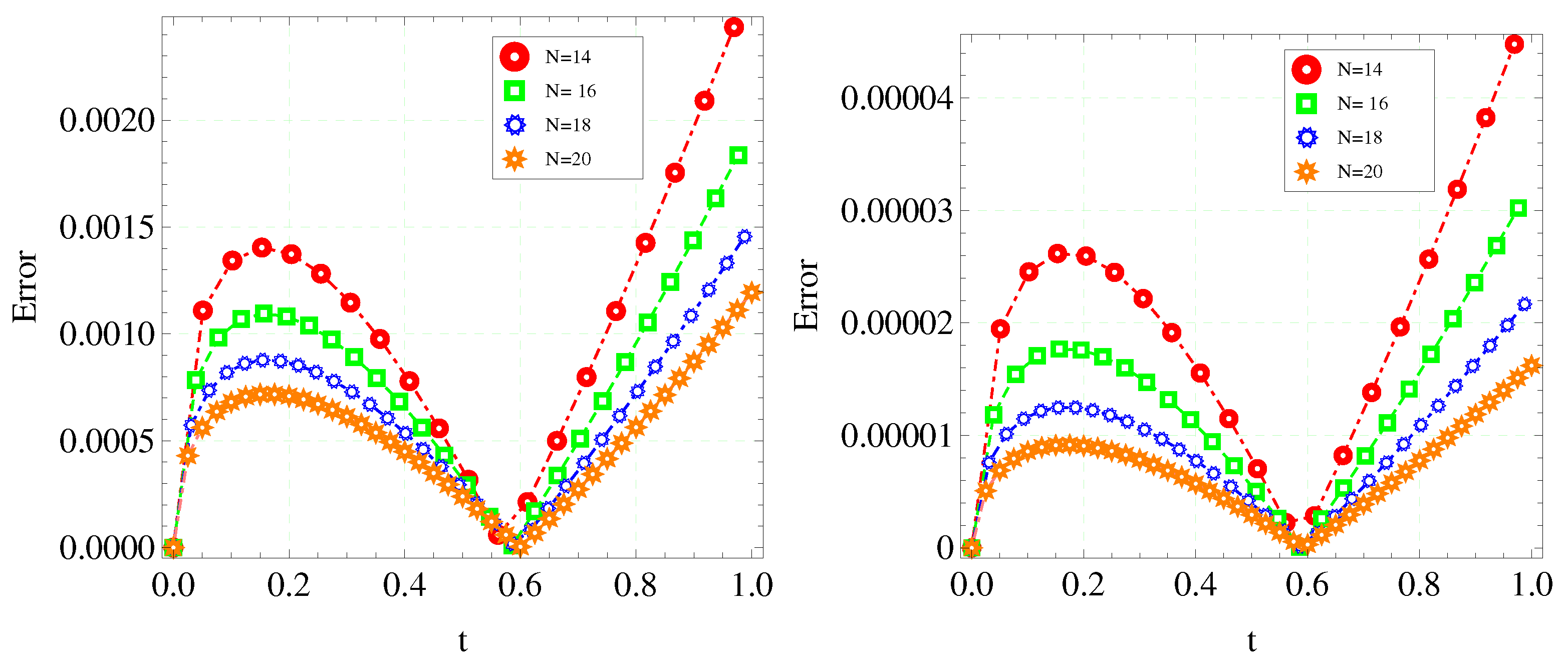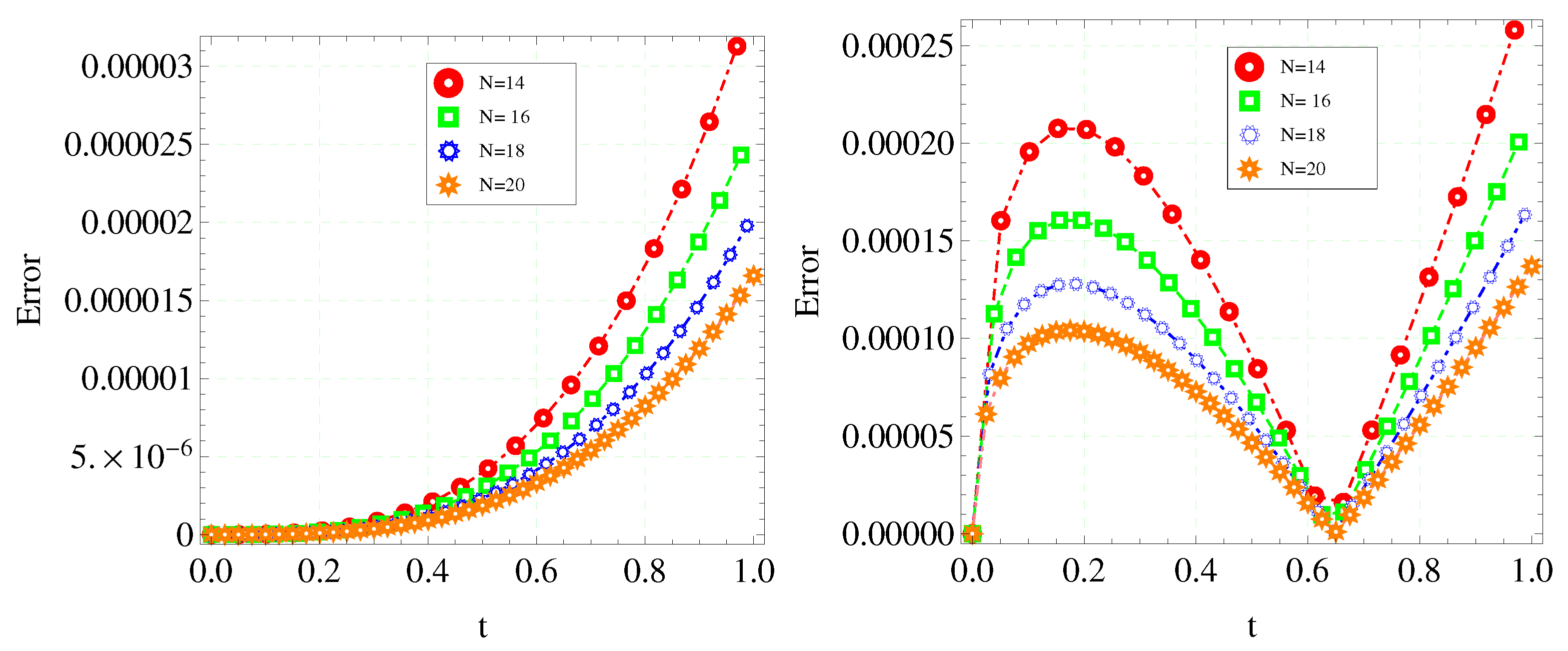1. Introduction
In recent years, the numerical approximation for the solutions of FDEs has attracted increasing attention in many fields of applied sciences and engineering [
1,
2,
3]. It is common for FDEs to be used in formulating many problems in applied mathematics. Developing numerical methods for fractional differential problems is necessary and important because analytic solutions are usually challenging to obtain. Moreover, it is necessary to develop numerical methods that are highly accurate and easy to use.
It is well known that fractional derivatives have different definitions; the most common and important ones in applications are the Riemann–Liouville and Caputo fractional derivatives. Models describing physical phenomena usually prefer the use of the Caputo derivative. One of the reasons is that the Riemann–Liouville derivative needs initial conditions containing the limit values of the Rieman–Liouville fractional derivative at the origin of time. In contrast, the initial conditions for Caputo derivatives are the same as for integer-order differential equations. Therefore, using the Caputo derivative, there is a clear physical interpretation of the prescribed data; see [
1,
4,
5].
Numerous research papers have been published on numerical methods for FDEs. Many researchers considered the trapezoidal method, predictor-corrector method, extrapolation method, and spectral method [
6,
7,
8,
9,
10,
11,
12,
13,
14,
15,
16]. Some of these methods discretize fractional derivatives directly. As an example, the L1 formula was created by a piecewise linear interpolation approximation for the integrand function on each small interval [
17,
18]. In [
19], the authors applied quadratic interpolation approximation using three points to approximate the Caputo fractional derivative, while in [
20], a technique based on the block-by-block approach was presented. This technique became a common method for equations with integral operators. In [
21], Caputo fractional differentiation was approximated by a weighted sum of the integer order derivatives of functions. In [
22], several numerical algorithms were proposed to approximate the Caputo fractional derivatives by applying higher-order piecewise interpolation polynomials and the Simpson method to design a higher-order algorithm.
These methods are appropriate options if the resulting system of equations, generated from the numerical method, is linear and well-conditioned. However, they present a high computational cost when the problem we are solving is badly conditioned or nonlinear. In light of the above discussion and the analysis of other methods for FDEs, despite many papers on numerical methods for FDEs, there are still insufficient efficient numerical approaches for such equations. Therefore, further studies are still in demand. In this case, step-by-step methods such as the Runge–Kutta method are a good option. They are favored due to their simplicity in both calculation and analysis.
Several authors have used Runge–Kutta methods to solve ordinary, partial differential, and integral equations [
23,
24,
25,
26,
27,
28,
29,
30]. Lubich and others have done some fundamental works regarding Runge–Kutta methods for Volterra integral equations [
28,
29,
30]. They used the order conditions to derive various Runge–Kutta methods.
One of the efficient implicit Runge–Kutta methods for the numerical approximation of some linear partial differential equations is the Rosenbrock procedure. It is a class of semi-implicit Runge–Kutta methods for the numerical solution of some stiff systems of ODEs. In Osterman and Rochet’s papers [
31,
32], the authors apply the Rosenbrock methods to solve linear partial differential equations, obtaining a sharp lower bound for the order of convergence. They show that the order of convergence is, in general, fractional. So, for the numerical solution of some fractional linear partial differential equations, we can construct fractional Rosenbrock-type methods, in which a special type of fractional semi-implicit Runge–Kutta method could be considered.
This paper introduces a new class of fractional order Runge–Kutta methods for numerical approximation to the solution of FDEs. Using the Caputo generalized Taylor series formula for the Caputo fractional derivative, we construct explicit and implicit FORK methods comparable to the well-known Runge–Kutta schemes for ordinary differential equations.
The remainder of the paper is organized as follows. In
Section 2, we review some definitions and properties of fractional calculus. We propose new explicit and implicit FORK methods for solving FDEs in
Section 3 and
Section 4. In
Section 5, the theoretical analysis of the convergency, stability, and consistency of the proposed methods is presented. Finally, in
Section 6, some numerical examples demonstrate the effectiveness of the methods proposed. Also, in
Appendix A two Mathematica computer programming codes are given.
3. Fractional Order Runge–Kutta Methods
This section presents a new class of FORK methods for the numerical solutions of FDEs. Consider the following FDE with
:
where
and
is called the base point of fractional derivative.
We set
,
, where
is the step size,
N is a positive integer (in
Section 5, we prove that
). For the existence and uniqueness of the solution of the FDE (
3), we consider the following theorem [
4].
Theorem 2. Let , , and and also let the function be continuous and fulfill a Lipschitz condition with respect to the second variable, i.e.,with some constant independent of and . DefineandThen, there exists a unique function solving the initial-value problem (3). In the sequel, we assume has continuous partial derivatives with respect to t and y to as high an order as we want.
Now, we introduce an s-stage explicit fractional order Runge–Kutta (EFORK) method for FDEs, which is discussed completely with and stages.
Definition 4. A family of s-stage EFORK methods is defined aswithwhere the unknown coefficients and the unknown weights , has to be determined. To specify a particular method, one needs to provide
and
,
accordingly. Following Butcher, [
23], a method of this type is designated by the following scheme:
|
| |
|
| | |
| ⋮ | ⋮ | | ⋱ |
|
| | | ⋯ | | |
| | | | ⋯ | | |
We expand
in (
5), in powers of
, such that it agrees with the Taylor series expansion of the solution of the FDE (
3) in a specified number of terms (see [
35]). According to (
2), the generalized Taylor formula for
with respect to the Caputo fractional derivative of the function
is defined as follows:
where using (
3),
Now, we obtain explicit expressions for (7).
Caputo fractional derivatives of composite function
can be computed by fractional Taylor series:
where
is the Caputo fractional derivative of
with respect to
t. After inserting
from (
6) in (
8) and by using the fractional derivative of (
8) for
, we have
and so
In addition,
which yields
In a similar manner with (
9) and (
10), we can obtain the higher fractional derivatives of
.
Now, by using (
9) and (
10), we have
where
,
represents the
ith integer derivative of the function
with respect to
y. As we can see from (
6), in Caputo fractional derivatives
,
, the argument
in
and starting value in
are the same.
To construct an efficient numerical scheme, we should obtain a similar series with the derivatives evaluated in any other point (
), such that the expansion can be constructed independently from the starting point
. In other words, we need
and
. To do so, by using
, we obtain
for
, as
By using the linear Lagrange interpolation formula for
in support abscissas
, we have
where, for a sufficiently small
h, we have
and
From (
13) and
, we have
So we may write
where
and for
we have
Clearly,
is continuous and satisfies the Lipschitz condition with respect to the second variable, due to the properties of
In what follows, for convenience of notation, we rename
as
, i.e., in any initial points
,
, we consider the right terms of (
14) as
instead of
in any stages.
Now, to construct FORK methods, we can use the Taylor formula (
6) and (
11), where
is defined in (
14).
3.1. EFORK Method of Order
Let us introduce the following EFORK method with two stages:
where coefficients
and weights
are chosen to make the approximate value
as close as possible to the exact value
. We expand
and
about the point
, where we use the Caputo Taylor formula (
12) about point
and standard integer-order Taylor formula about
as
Substituting
and
in (
15), we have
Comparing (
12) with (
16) and matching coefficients of powers of
, we obtain three equations:
From these equations, we see that, if
is chosen arbitrarily (nonzero), then
Inserting (
17) and (
18) in (
16) we get
Subtracting (
19) from (
12), we obtain the local truncation error
We conclude that no choice of the parameter
will make the leading term of
vanish for all functions
. Sometimes, the free parameters are chosen to minimize the sum of the absolute values of the coefficients in
. Such a choice is called the optimal choice.
From (
20) we have
. So, we deduce that the 2-stage EFORK method (
15) is of order
.
Now, the two-stage EFORK method by listing the coefficients is as follows:
,
Choosing
yields
|
| | | . |
| | | |
In addition, the optimal cases of the two-stage EFORK method are
|
| | | , |
| | | |
|
| | | , |
| | | |
|
| | | . |
| | | |
3.2. EFORK Method of Order
Following (
4) and (
5), we define a three-stage EFORK method as
where unknown parameters
, and
have to be determined accordingly. By using the same procedure as we followed for the two-stage EFORK method, expanding
,
and
, comparing with (
12) and matching coefficients of powers of
, we obtain the following equations:
Now, we have six equations with eight unknown parameters. According to the Butcher tableau for the three-stage EFORK method, we have
|
| |
|
| | | |
| | | | |
If
and
are arbitrarily chosen, we calculate weights
and coefficients
from (
22) as
|
|
|
|
|
| | |
| |
|
|
|
As a result, we obtain . In a similar procedure to the two and three-stage EFORK methods, we can construct s-stage EFORK methods for
As we can see, to obtain the higher fractional order Runge–Kutta methods, we must consider a method with additional stages. In the next section, we express implicit fractional order Runge–Kutta (IFORK) methods with low stages and high orders.
4. IFORK Methods
We define a
s-stage IFORK method by the following equations:
and
where
and the parameters
,
are arbitrary. We state the IFORK method by listing the coefficients as follows:
|
| | ⋯ | | | | ⋯ | |
|
| | ⋯ | | | | ⋯ | |
| ⋮ | ⋮ | ⋮ | ⋮ | ⋮ | ⋮ | ⋮ | ⋮ |
|
| | ⋯ | | | | ⋯ | |
| | | | | | | ⋯ | |
Since the functions are defined by a set of s implicit equations, the derivation of the implicit methods is complicated. Therefore, only the case is investigated.
Consider (
23)–(
25) with
as
where
By using a similar procedure as we followed for the EFORK method, we expand
about the point
, where we apply the Caputo Taylor formula (
12) about
and standard integer-order Taylor formula about
.
where
.
Since Equation (
29) are implicit, we cannot obtain the explicit forms for
and
. To determine the explicit form
, we consider
where
,
and
are unknowns. Substituting (
30) into (
29) and matching the coefficients of powers of
, we get
Inserting (
30) and (
31) into (
27), we have
Comparing (
32) with (
12) and equating the coefficient of powers of
, we can get an IFORK method of different orders.
4.1. IFORK Method of Order
To obtain an IFORK method of order
, we equate the coefficients of
and
in (
12) and (
32) correspondingly to get
where
There are now six arbitrary parameters to be prescribed. If we neglect
, i.e., if we choose
,
, from the above equations, we find
Therefore, a one-stage IFORK method of order
is obtained as follows:
4.2. IFORK Method of Order
In addition, we can get an IFORK method of order
with two stages (
26)–(
28) when equating the coefficients of
,
and
in (
12) and (
32) accordingly. In such case, we obtain the following system of equations:
where
The three free parameters can be chosen so that
or
are explicit. If we want
to be explicit, we choose
Thus, the IFORK method of order
, which is explicit in
is given by
where the coefficients are given by
|
| | | |
|
| | | | , |
| | | | |
| 0 | 0 | 0 | 0 |
|
|
|
|
| | |
|
|
6. Numerical Examples
In order to demonstrate the effectiveness and order of accuracy of the proposed methods in
Section 3 and
Section 4, two examples are considered. All computations have been carried out on a Core i7 PC with Mathematica 13.2 software.
Example 1. Consider the fractional differential equationsuch that the exact solution is . The approximate solutions by the two-stage EFORK method (15), three-stage EFORK method (21), and IFORK methods (33) and (34) are reported in Table 1, Table 2, Table 3, Table 4, Table 5 and Table 6 (In Appendix A some Mathematica computer programming codes are presented). The computed solutions are compared with the exact solution for different values of h, α, and T. The absolute error in time T is given byand the orders of the presented method are computed according to the following relation: From the
Table 1,
Table 2,
Table 3,
Table 4,
Table 5 and
Table 6, we can conclude that the computed orders of truncation errors are in good agreement with the obtained results of
Section 3 and
Section 4.
Figure 4, illustrates the error curves of the two-stage EFORK method (
15) and the three-stage EFORK method (
21) at
with
,
and different values of
N.
Example 2. Consider the following fractional differential equation from [6]:with the exact solution . Again, for different values of h, α, and T, we compared, in Table 7, Table 8, Table 9 and Table 10, the obtained results by the two-stage EFORK method (15) and the three-stage EFORK method (21) with the exact solution. In Table 11 and Table 12, we report the results obtained by the IFORK methods (33) and (34). From Table 7, Table 8, Table 9, Table 10, Table 11 and Table 12, we can conclude that the computed orders are in good agreement with the given results of Section 3 and Section 4. As we can see, the computational orders for two and three-stage EFORK methods approach
and
for
, respectively. As seen in Tables and Figures, the three-stage EFORK method provides better results than the two-stage EFORK method.
Table 13 shows the numerical results for different values of
T.
In addition,
Table 5,
Table 6,
Table 11 and
Table 12 show that the computational order from relations (
33) and (
34) of IFORK methods approach
and
for
, respectively.
Figure 5, illustrates the numerical results of the two-stage EFORK method (
15) and the three-stage EFORK method (
21) at
for
,
and different values of
N. Additionally,
Figure 6 illustrates the numerical results of the IFORK method (
33) for Example 1 and Example 2 at
for
,
and different values of
N.
In addition, the numerical results for the optimal case
in the two-stage EFORK method are shown in
Table 14 with
and different values of
h.
